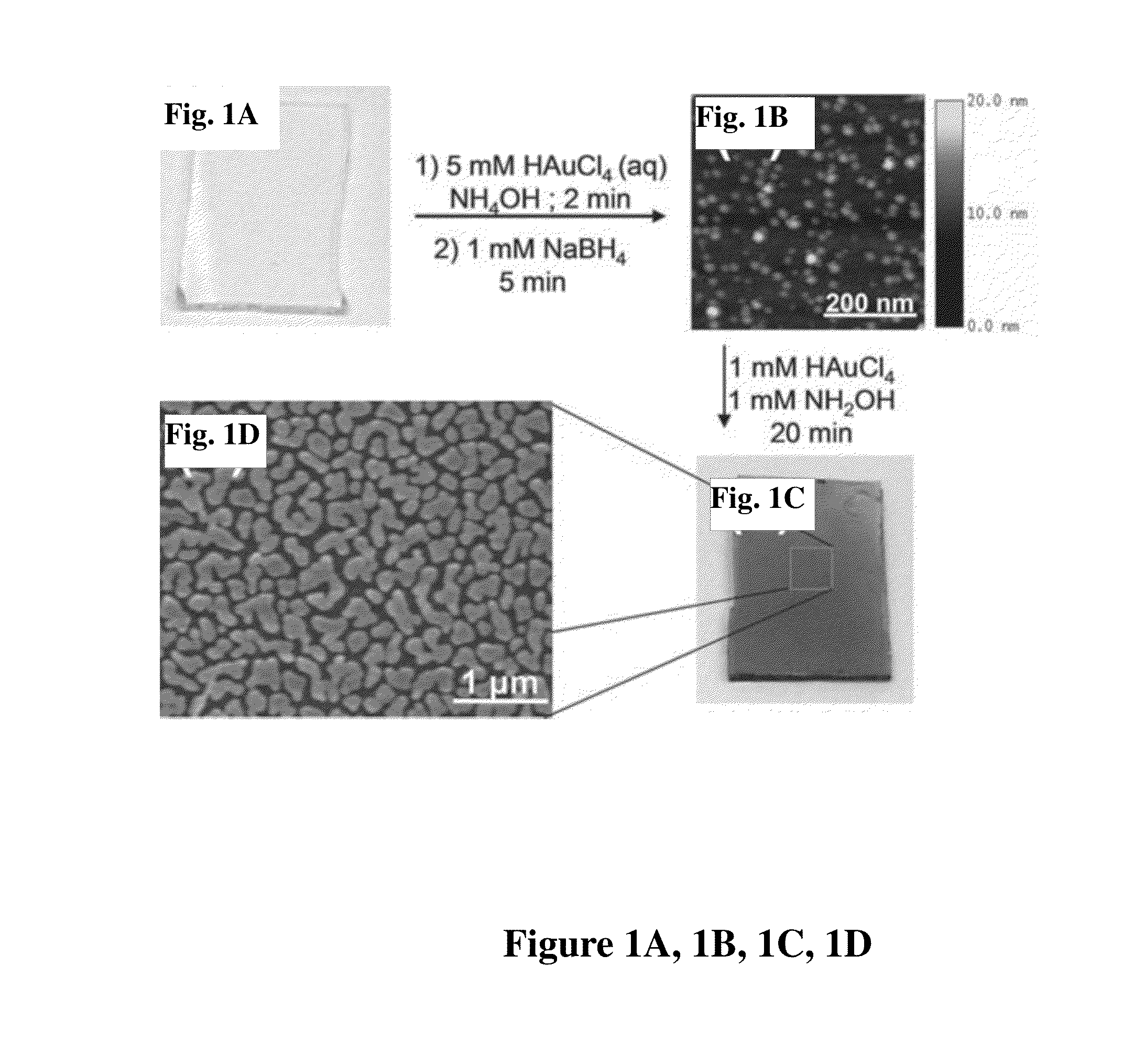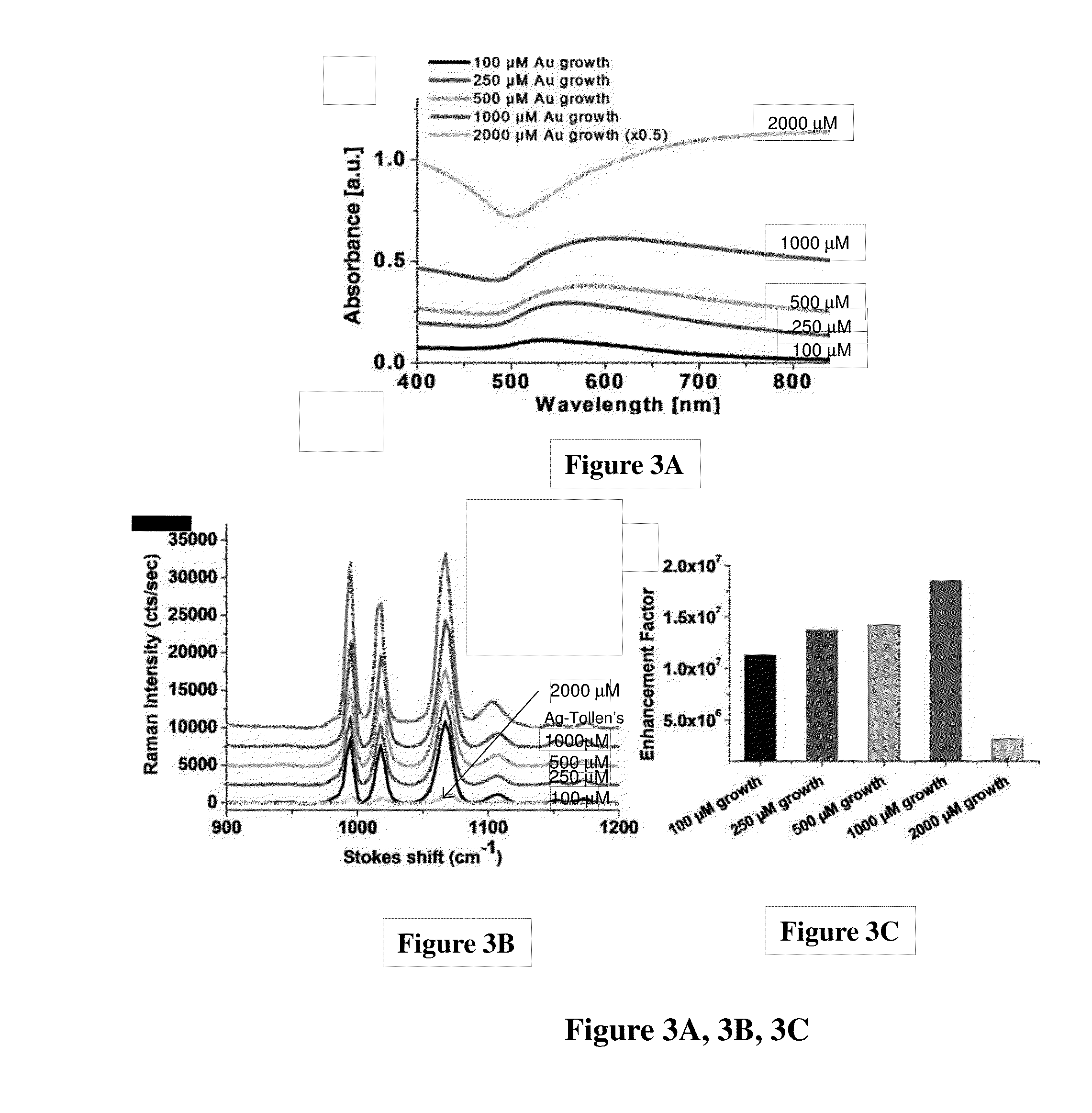Fluorescence enhancing plasmonic nanoscopic gold films and assays based thereon
a plasmonic gold and fluorescence-enhancing technology, applied in the field of nanostructured plasmonic metal film formation, can solve the problems of oxidation and instability problems of ag, complex and expensive methodologies and instruments, and the inability to prepare highly stable plasmonic gold substrates. to achieve the effect of enhancing plasmonic near-infrared fluorescen
- Summary
- Abstract
- Description
- Claims
- Application Information
AI Technical Summary
Benefits of technology
Problems solved by technology
Method used
Image
Examples
examples 1-5
[0102]These examples pertain to the preparation of the solution phase gold films. Briefly, gold-on-gold (Au / Au) substrates were produced in the following general manner. The substrate of choice was submersed in a solution of chloroauric acid, to which ammonium hydroxide was added at 20 μL / mL (0.6% ammonia), under vigorous agitation for one minute. Following incubation in the seeding solution, the substrate was washed by sequential immersion into two water baths. Immediately following the wash steps, the Au3+ seeded substrate was submersed into a solution of 1 mM sodium borohydride at room temp on an orbital shaker or agitated manually. Reduction was allowed to proceed for 1-5 minutes, followed by two submersions of the substrate in water baths. Au nanoparticle-seeded substrates were moved directly from wash water baths to a 1:1 (by concentration) solution of HAuCl4 and NH2OH under vigorous agitation to initiate growth. Growth proceeded at room temperature on an orbital shaker at 100...
examples 6-13
[0115]These examples pertain to protein microarrays prepared on a similar nanostructured, plasmonic gold film to that described in Section I, optimized to provide, rather than a surface-enhanced Raman scattering effect, near-infrared fluorescence enhancement, of up to 100-fold, extending the dynamic range of protein detection by three orders of magnitude towards the fM regime. This is termed NIR fluorescence enhancement (NIR-FE). NIR-FE is a physical phenomenon similar to surface enhanced Raman scattering (SERS) but remains much less well known or studied than SERS for biology and medicine.
[0116]Plasmonic protein microarrays are demonstrated for use in early detection of a cancer biomarker, carcinoembryonic antigen, in the sera of mice bearing a xenograft tumor model. Further exemplified is a multiplexed autoantigen array for human autoantibodies implicated in a range of autoimmune diseases with superior signal-to-noise ratios and broader dynamic range compared to commercial nitroce...
examples 14-17
[0142]The following examples describe the use of the Au / Au films for the imaging of cells using near-infra red fluorescence. A common caveat of NIR fluorophores is the relatively low quantum yields compared to their counterparts (including organic dyes and quantum dots) with shorter emission wavelengths in the visible, which limits their imaging capabilities. For example, the IR800 dye (with a peak emission wavelength of 800 nm) exhibits a ˜10% quantum yield, and the indocyanine green (ICG) dye exhibits only ˜4.3% quantum yield at the emission wavelength of 805 nm.[22] In contrast, molecules fluorescing at shorter wavelengths typically exhibit much higher quantum yields (IR700 ˜24% at 700 nm emission cyanine-5 ˜30% at 660 nm emission; fluorescein ˜91% at 521 nm emission). SWNTs exhibit quantum yield ranging from 0.1% to 3%, due to intrinsic low-energy excitons that are optically forbidden, and extrinsic quenchers such as metallic SWNTs in bundles and oxygen in acidic environment. To...
PUM
| Property | Measurement | Unit |
|---|---|---|
| size | aaaaa | aaaaa |
| size | aaaaa | aaaaa |
| area | aaaaa | aaaaa |
Abstract
Description
Claims
Application Information
 Login to View More
Login to View More - R&D
- Intellectual Property
- Life Sciences
- Materials
- Tech Scout
- Unparalleled Data Quality
- Higher Quality Content
- 60% Fewer Hallucinations
Browse by: Latest US Patents, China's latest patents, Technical Efficacy Thesaurus, Application Domain, Technology Topic, Popular Technical Reports.
© 2025 PatSnap. All rights reserved.Legal|Privacy policy|Modern Slavery Act Transparency Statement|Sitemap|About US| Contact US: help@patsnap.com



